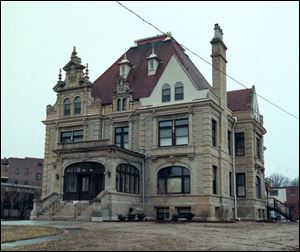
Federal credit gives new life to old buildings
7/21/2002
The Bartley Mansion's rehabilitation was made possible, in part, by federal tax credits.
It's a good time to be an old building in Ohio and Michigan, with developers scoring big on redevelopment projects, and the federal government ready to refund 20 percent of the money invested if the work is done just so.
About 900 historic buildings in Ohio have been rehabilitated under the federal tax credit program since its 1976 introduction, including the Commodore Perry Apartments, the Hillcrest, the Ohio Building, and Museum Place in Toledo.
Ohio has about 54,000 buildings on the National Register of Historic Places; 87 of them in Lucas County. The state recently passed the $1 billion mark in use of the federal credit.
Michigan's program is even more generous: since 1999, it has offered its own 5 percent state tax credit in addition to the federal program.
A total of 205 projects in 24 counties have applied for the state tax break, which the Michigan Historic Preservation Network says contributed to a total of $16 million in direct rehabilitation spending.
Still, owners of dozens of qualifying structures have not taken advantage of the government programs.
“The [federal] credit has been a wonderful thing,” said Martha Raymond, head of technical preservation services for the Ohio Historic Preservation office, which administers the program statewide.
“It's true, the application process is a long one, and the building has to be recognized as a historic structure, or a part of a historic district. The design must meet a series of standards, and you have to submit lots of photos and drawings and plans. It takes months. It's very thorough.”
Toledo's abundant parking lots notwithstanding, developers and government officials have scored some successes in recent years, finding new uses for many old, empty buildings.
In 1996, the Del Mar Apartments at 2350 Monroe Street was an eyesore, a blight on the pretty Old West End block facing the Toledo Museum of Art. The handsome, four-story apartment building was built in 1917, a distinguished residence at the time. But by 1980, it was empty, ripe for the wrecking ball.
But a cooperative effort by the nonprofit Neighborhoods in Partnership and for-profit rehabilitation specialists Vistula Management Co. joined together to save the Del Mar and several adjacent buildings, with an extra boost provided by the Historic Preservation tax break. The district now is known as Museum Place.
“The historic building credit is an excellent program for projects of substance,” said Kathleen Kovacs, executive director of Neighborhoods in Partnership.
“If you're a small mom-and-pop operation, it may not be worth it. But if you're looking at the Madison Building downtown, or the Pythian Castle, it would really be worth it,” she said.
“This is a real win-win,” said Amos Loveday, Jr., Ohio's state historic preservation officer. “Older buildings are being thoughtfully preserved and reused, which stimulates the local economy, while owners are being rewarded for going the extra mile. The credit helps provide affordable housing, stimulate private investment, bring business and customers back downtown, attract tourists, and strengthen community pride.”
In Toledo, old hotels and warehouses are once again hopping, happening hot spots, redeveloped into apartments and condominiums for hundreds of families. In the last 10 years, an estimated 2,500 people moved downtown to live where Hollywood stars once danced, or fruit, meat, and cheese once ripened.
Spurred by redevelopment successes near the new Fifth Third Field, developers are eyeing empty downtown structures for possible development - and several are on the all-important Historic Landmarks list.
The Berdan Building, the King Warehouses, Burt's TheaterCaesar's Show Bar, and the embattled Brenda's Body Shop building are qualified structures.
But there are plenty of reasons not to take the government offer, one local developer said.
“They're intrusive when it comes to our finances, and they're restrictive when it comes to architectural replications,” said Joseph Ballmer, a Maumee architect and developer who is turning the old Lucas County Children's Home campus in Maumee into a luxury condominium community.
“It's an invitation to the government to teach you how to run your business and how to redevelop your real estate. We're not interested,” he said. “It's a bureaucratic paperwork ordeal. It's not a bad program. It's just not for us.”
“It's true, it's not for everybody,” Ms. Raymond said. “If someone doesn't like paperwork, well ... but some other people really make good use of it.
“I have no statistical evidence that this ever actually saved an endangered building. But 20 percent [federal funding], that can make or break some projects' financing. And it has a domino effect on entire communities. One person does it, and the word gets out,” Ms. Raymond said.
Ms. Raymond noted that her office is “here to help first-timers get through the paperwork.”
Rehabilitating a sagging structure is often more costly than building one, Ms. Kovacs said.
“But sometimes, the tax credit really takes the edge off that price difference. This is money that can make a project viable, and it can save some of our beautiful old buildings too.”